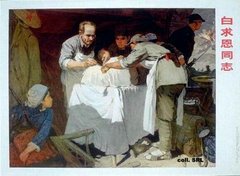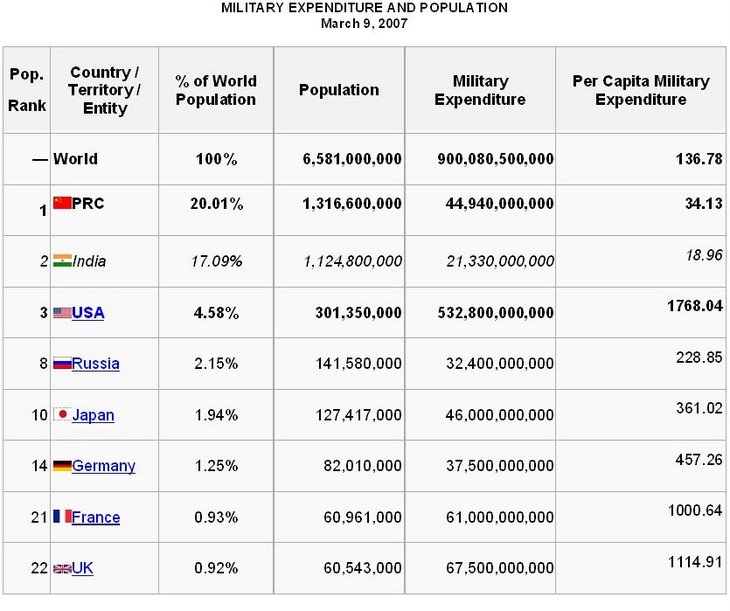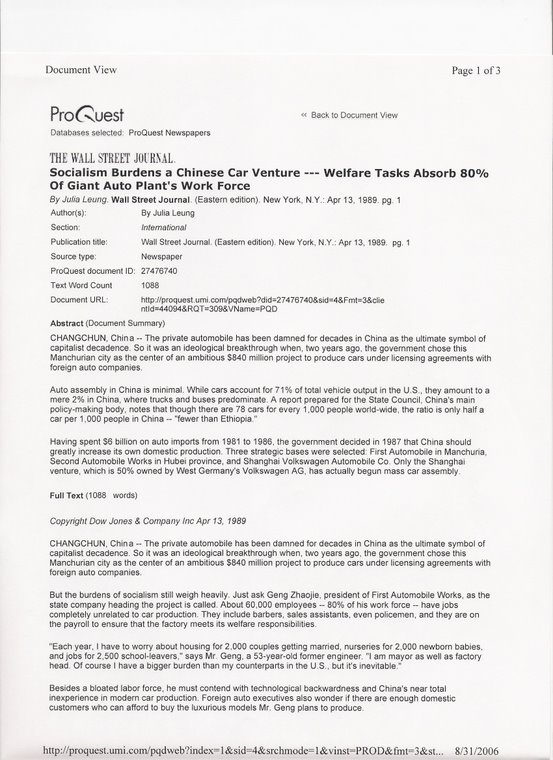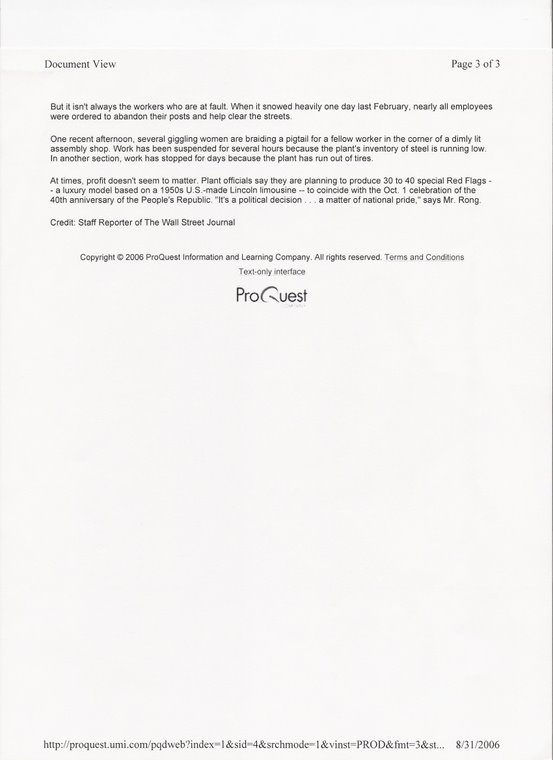Sunday, March 25, 2007
China... the Trade Off in having capitalist partners
We would like to share an article from Beijing Review on the impact and problems that have developed with China’s Opening to the West as it expresses itself in trade and investment relations. Without a doubt, for historic reasons of low-cost production in colonial China which has achieved modernization in only part of its country where more than two-thirds remain undeveloped, China has nevertheless emerged as a viable competitor to major capitalist countries. At the same time, it is a valued customer for raw materials from many undeveloped and developing countries, giving them opportunity for independent growth. In fact, the US has raised sharp complaints in the WTO against what they claim is China’s subsidizing exports. Of course, the US will not own up to the fact that its subsidies to cotton growers has kept the price of US cotton low and resulted in 10,000 African farmers being put out of production.
The West, particularly the US Treasury, is pinning the solution on increasing the value of Chinese currency as though a change in the means of exchange would resolve what is essentially a production problem. No doubt, some adjustments can be made in tariffs, import, and export, arrived at in reasonable negotiations and the opening of trade and investment privileges. Of course, China is making efforts to increase consumption in its own country to absorb a larger share of the GDP and rely on production for export. This is a long term process and will depend upon the rapidity with which the Hu government creates the Socialist Welfare State they promise to be in place by 2020 for 90% of the population.
A more equitable share of wealth in China will go a long way to resolve the competitive inequalities that have arisen. However, in the interim, the trade imbalances can be alleviated if opportunities for China’s imports from countries with large disproportions would help both China in its economic growth and the complaining countries would have a higher level of exports to China. The result is a more workable balance; but this means that countries like the USA must relax its policy of refusing the sale of heavy and high tech equipment to China and the right to make legitimate investments in production intended for export to China. Unfortunately, US super-power politics is in the way of logical economic decision-making, though Bush has encouraged one major technology deal.
The kernel of solution of competitive realities is clearly noted in the last paragraph of the article “A Trade Off” by Zhou Jianxiong.
----------------------------------------------------------------------
A Trade Off
Beijing Review vol. 50 no. 7
February 15, 2007
By ZHOU JIANXIONG
China's growing trade surplus has become a major concern for some of its major trade partners, such as the United States and the European Union. As the latest statistics from China's Customs Administration suggest, while the country's export growth rate fell 1.2 percentage points and that of imports rose 2.4 percentage points, the total surplus grew $75.59 billion last year to hit a record high of $177.47 billion. This proves to be a direct cause of friction between China and these trade partners. By the third quarter of last year, 70 cases of antidumping and countervailing investigations had been launched against China, making it the world's primary target of trade punitive measures. In addition, this trade surplus has brought about overheated investment in the wake of huge capital deposits building up in the banking sector, a phenomenon the Chinese central authorities have vigorously sought to control in recent years.
Many Chinese scholars and trade officials have attributed the trade surplus to the massive transfer of global manufacturing industries to China, which has boosted its export potentials, and led to an overcapacity that curbs demand for more imports. Others believe that a stronger global demand for Chinese processed goods may be the cause. This is substantiated by figures from the Ministry of Commerce showing that the trade surplus from processed products has been greater than that of general trade over the past six years. A higher savings ratio is also held accountable for the trade surplus, as it gives rise to an accelerating pace of investment as well as inadequate domestic consumption.
Whatever the causes, this trade surplus remains and is still rising, and given its status in the globalization process, cheap labor and other resources, and current stage of social development, China is likely to maintain an overall surplus in foreign trade over a relatively long-term period.
This, however, does not mean that the Chinese Government is taking an indifferent attitude toward the issue. On the contrary, various measures have been adopted recently to curb the rising surplus, including setting up a managed floating exchange rate system, lowering the rate of export rebate, and concluding of procurement contracts worth billions of dollars abroad. Chinese leaders have reiterated on many occasions that China has no intention of pursuing a huge trade surplus with any other countries, and the Minister of Commerce Bo Xilai has declared the reduction of trade surplus one of his top priorities for 2007. Conceivably, a series of new policy readjustments will be made to attain the goal in the foreseeable future, ranging from a more liberalized floating exchange rate system, replacing export incentives with new policies that encourage import and investment overseas, to optimizing the lineup of export commodities and taking fresh steps to stimulate domestic consumption.
Some Western observers have pinned their hopes on the appreciation of the Chinese yuan, assuming that a higher exchange rate of renminbi will be a miraculous cure to easing the trade surplus. This is only correct on paper, for China's trade surplus does not originate from an imbalance of international trade, but is a result of the changing setup of global manufacturing activities and international division of labor and market. Under such circumstances, China really needs outside help from some of its trade partners to cut its trade surplus, such as lifting restrictions on China's purchase of hi-tech products and clearing the barriers to Chinese business investment abroad.
The West, particularly the US Treasury, is pinning the solution on increasing the value of Chinese currency as though a change in the means of exchange would resolve what is essentially a production problem. No doubt, some adjustments can be made in tariffs, import, and export, arrived at in reasonable negotiations and the opening of trade and investment privileges. Of course, China is making efforts to increase consumption in its own country to absorb a larger share of the GDP and rely on production for export. This is a long term process and will depend upon the rapidity with which the Hu government creates the Socialist Welfare State they promise to be in place by 2020 for 90% of the population.
A more equitable share of wealth in China will go a long way to resolve the competitive inequalities that have arisen. However, in the interim, the trade imbalances can be alleviated if opportunities for China’s imports from countries with large disproportions would help both China in its economic growth and the complaining countries would have a higher level of exports to China. The result is a more workable balance; but this means that countries like the USA must relax its policy of refusing the sale of heavy and high tech equipment to China and the right to make legitimate investments in production intended for export to China. Unfortunately, US super-power politics is in the way of logical economic decision-making, though Bush has encouraged one major technology deal.
The kernel of solution of competitive realities is clearly noted in the last paragraph of the article “A Trade Off” by Zhou Jianxiong.
----------------------------------------------------------------------
A Trade Off
Beijing Review vol. 50 no. 7
February 15, 2007
By ZHOU JIANXIONG
China's growing trade surplus has become a major concern for some of its major trade partners, such as the United States and the European Union. As the latest statistics from China's Customs Administration suggest, while the country's export growth rate fell 1.2 percentage points and that of imports rose 2.4 percentage points, the total surplus grew $75.59 billion last year to hit a record high of $177.47 billion. This proves to be a direct cause of friction between China and these trade partners. By the third quarter of last year, 70 cases of antidumping and countervailing investigations had been launched against China, making it the world's primary target of trade punitive measures. In addition, this trade surplus has brought about overheated investment in the wake of huge capital deposits building up in the banking sector, a phenomenon the Chinese central authorities have vigorously sought to control in recent years.
Many Chinese scholars and trade officials have attributed the trade surplus to the massive transfer of global manufacturing industries to China, which has boosted its export potentials, and led to an overcapacity that curbs demand for more imports. Others believe that a stronger global demand for Chinese processed goods may be the cause. This is substantiated by figures from the Ministry of Commerce showing that the trade surplus from processed products has been greater than that of general trade over the past six years. A higher savings ratio is also held accountable for the trade surplus, as it gives rise to an accelerating pace of investment as well as inadequate domestic consumption.
Whatever the causes, this trade surplus remains and is still rising, and given its status in the globalization process, cheap labor and other resources, and current stage of social development, China is likely to maintain an overall surplus in foreign trade over a relatively long-term period.
This, however, does not mean that the Chinese Government is taking an indifferent attitude toward the issue. On the contrary, various measures have been adopted recently to curb the rising surplus, including setting up a managed floating exchange rate system, lowering the rate of export rebate, and concluding of procurement contracts worth billions of dollars abroad. Chinese leaders have reiterated on many occasions that China has no intention of pursuing a huge trade surplus with any other countries, and the Minister of Commerce Bo Xilai has declared the reduction of trade surplus one of his top priorities for 2007. Conceivably, a series of new policy readjustments will be made to attain the goal in the foreseeable future, ranging from a more liberalized floating exchange rate system, replacing export incentives with new policies that encourage import and investment overseas, to optimizing the lineup of export commodities and taking fresh steps to stimulate domestic consumption.
Some Western observers have pinned their hopes on the appreciation of the Chinese yuan, assuming that a higher exchange rate of renminbi will be a miraculous cure to easing the trade surplus. This is only correct on paper, for China's trade surplus does not originate from an imbalance of international trade, but is a result of the changing setup of global manufacturing activities and international division of labor and market. Under such circumstances, China really needs outside help from some of its trade partners to cut its trade surplus, such as lifting restrictions on China's purchase of hi-tech products and clearing the barriers to Chinese business investment abroad.
Subscribe to:
Post Comments (Atom)












No comments:
Post a Comment